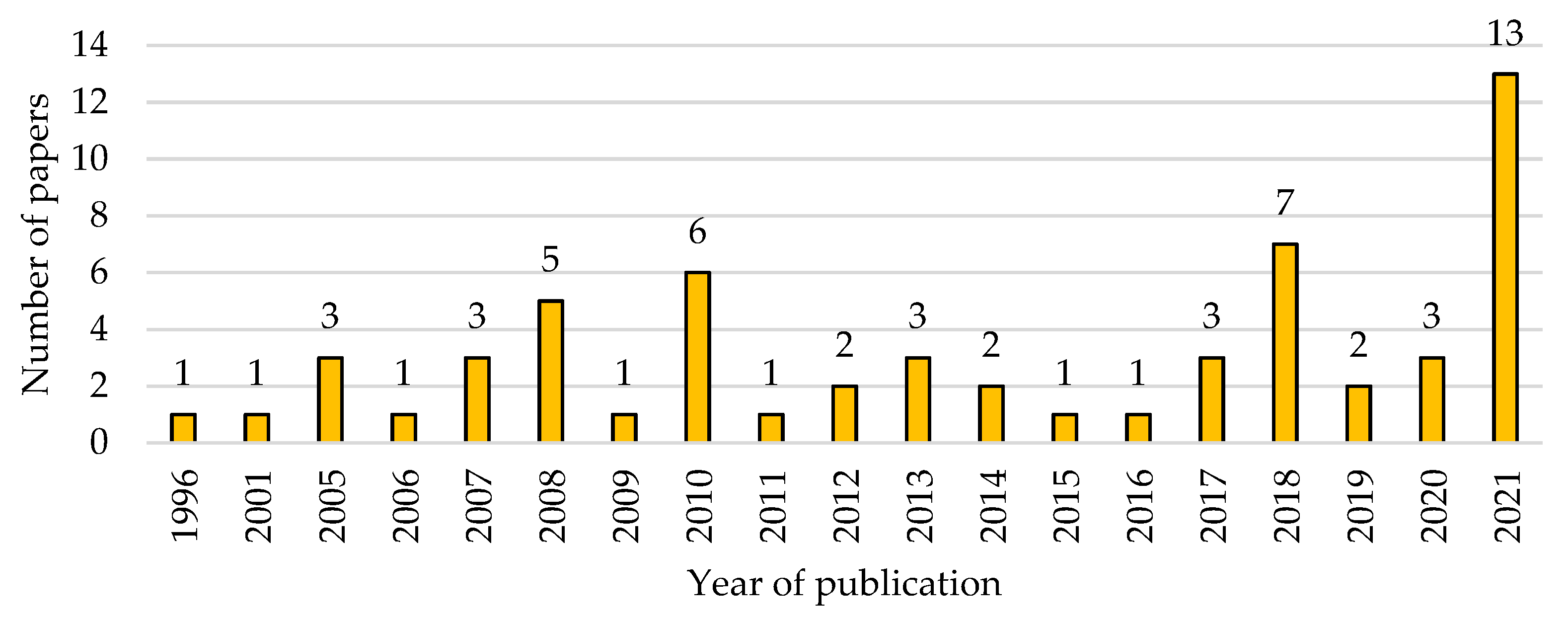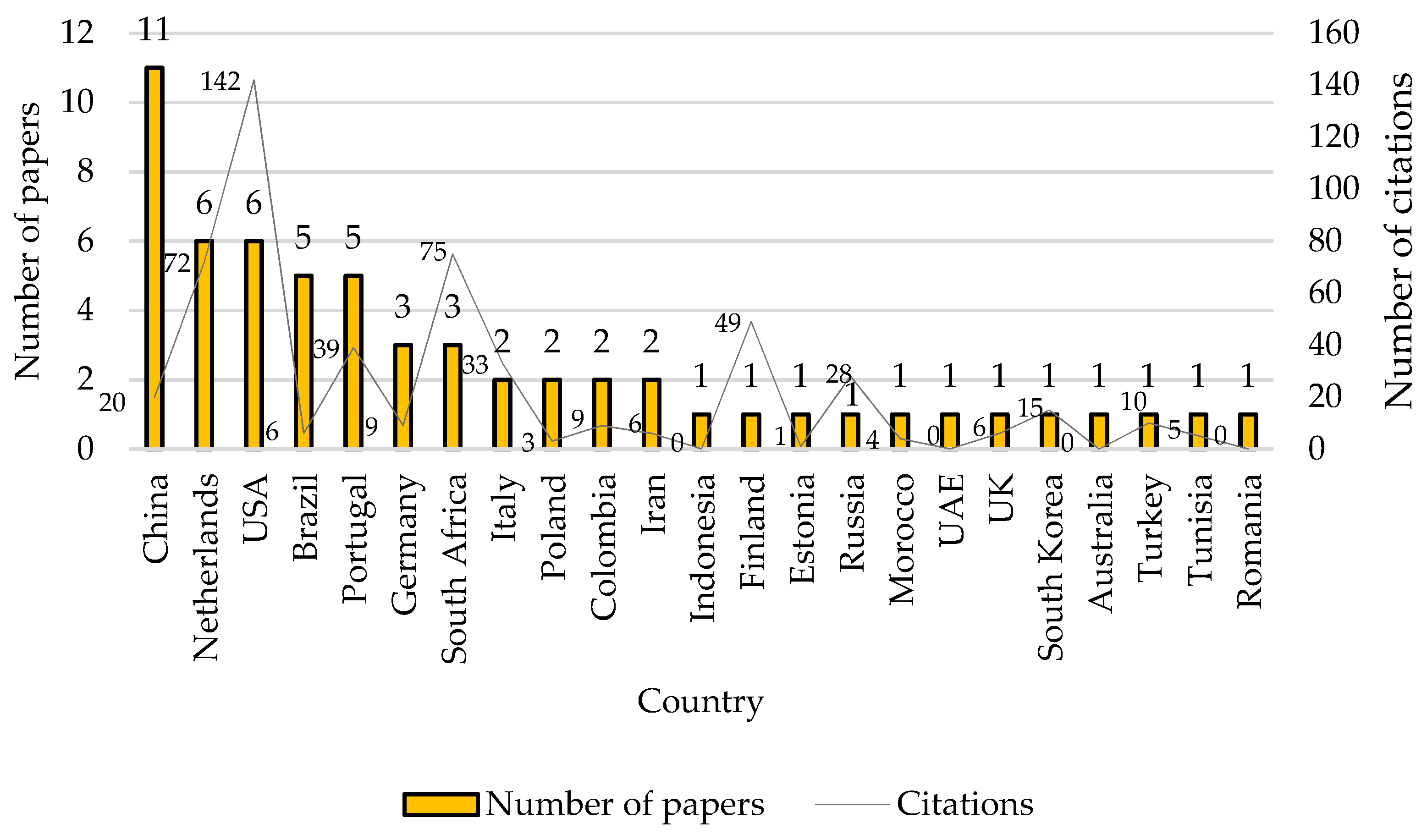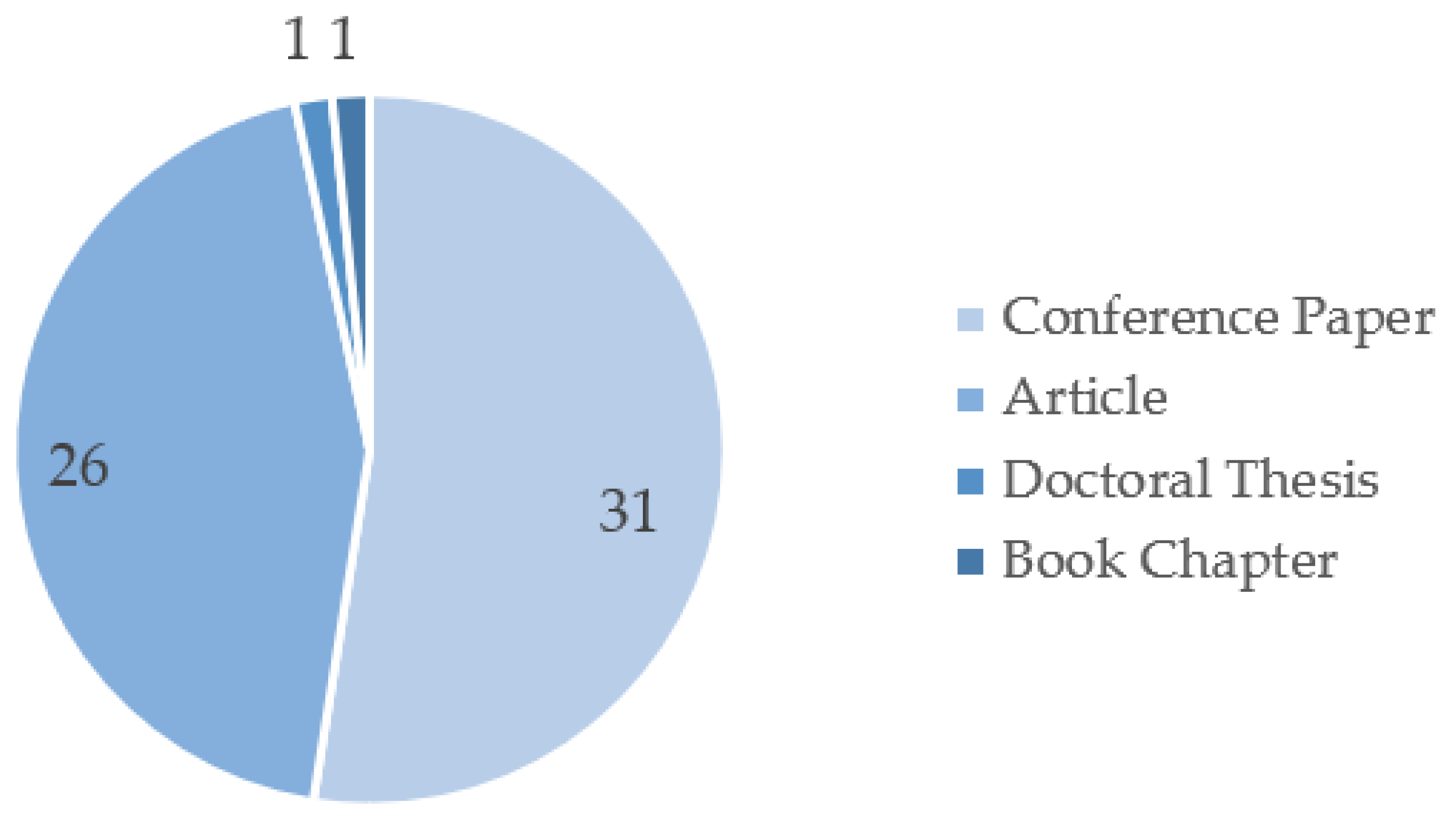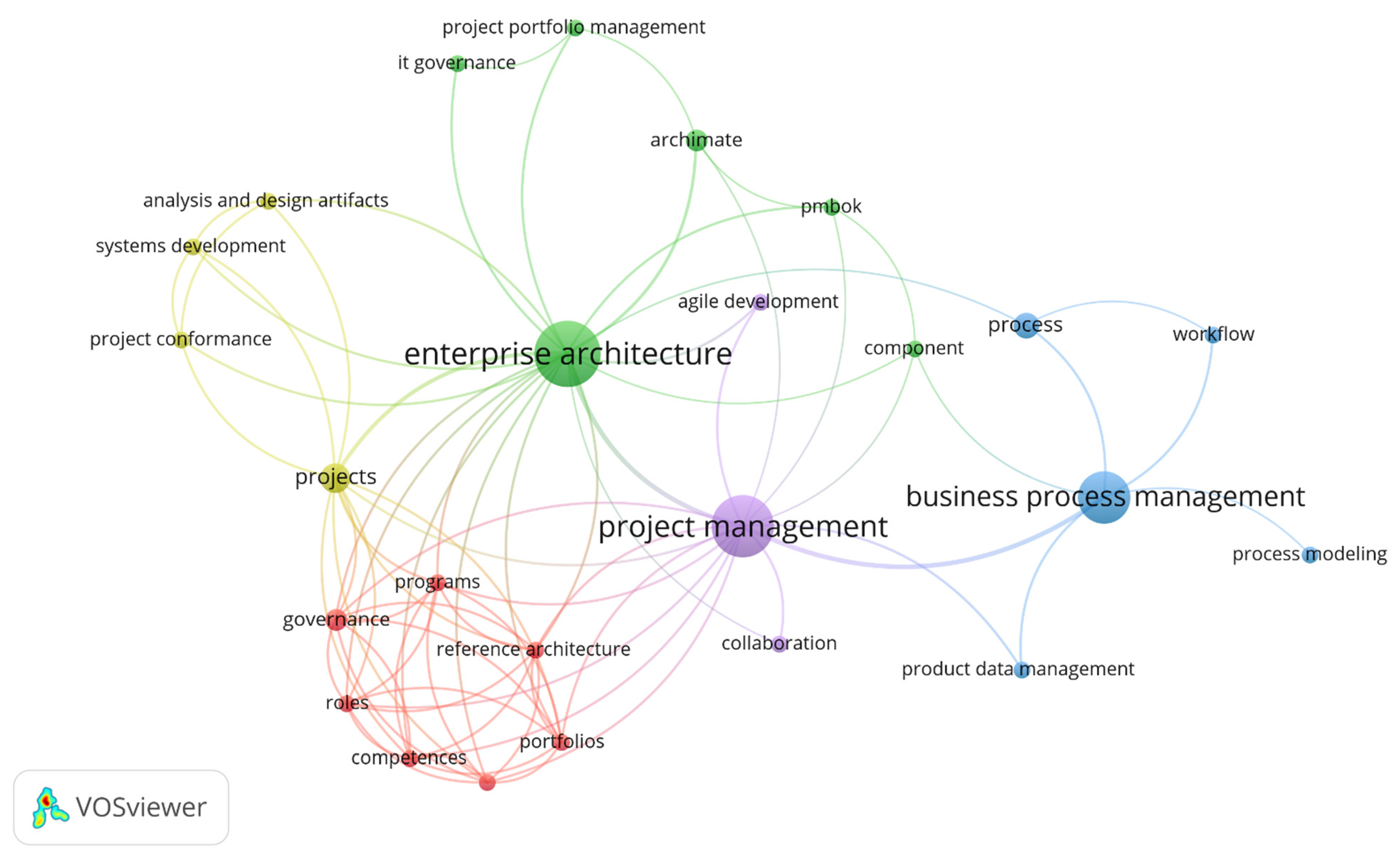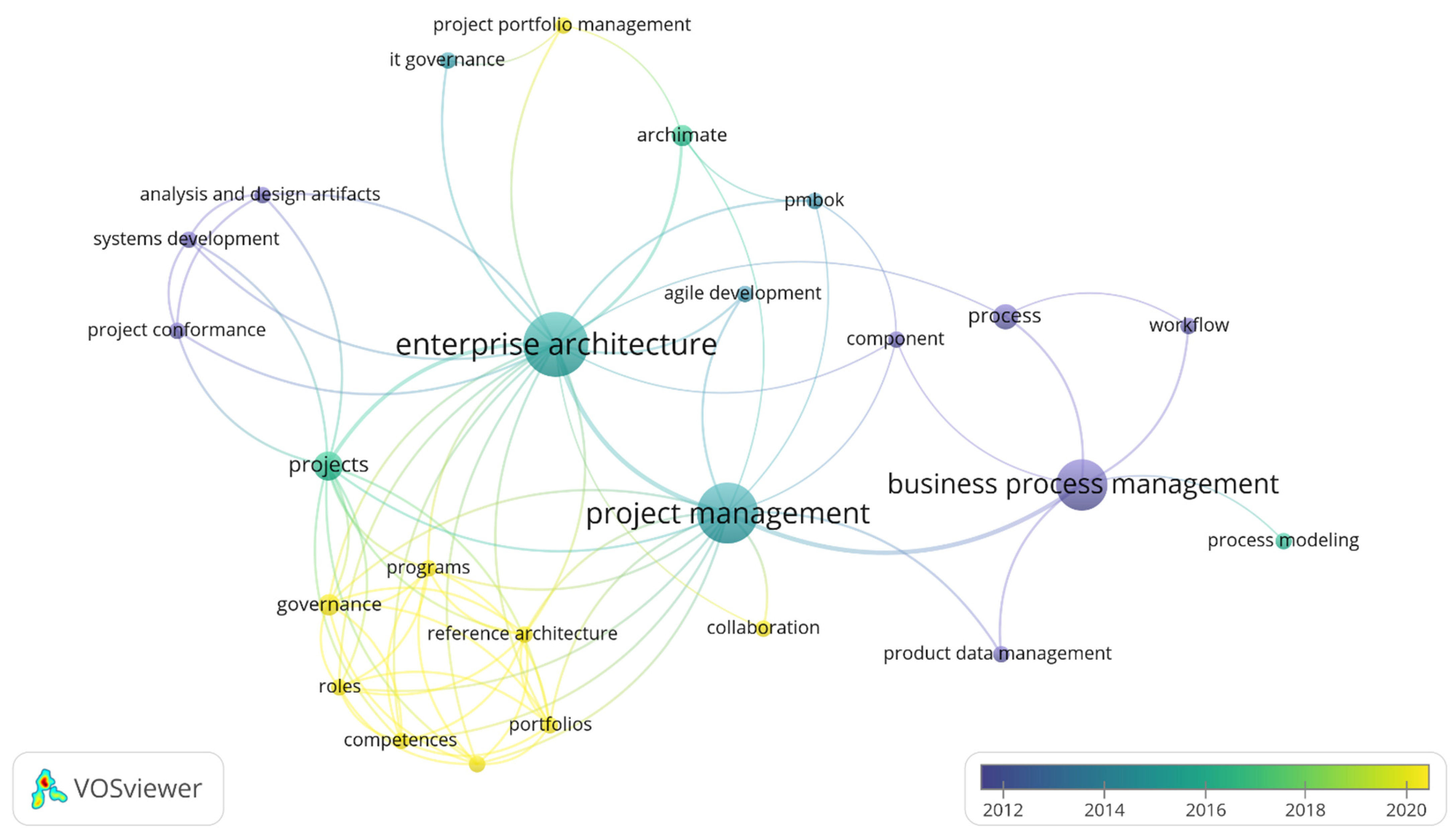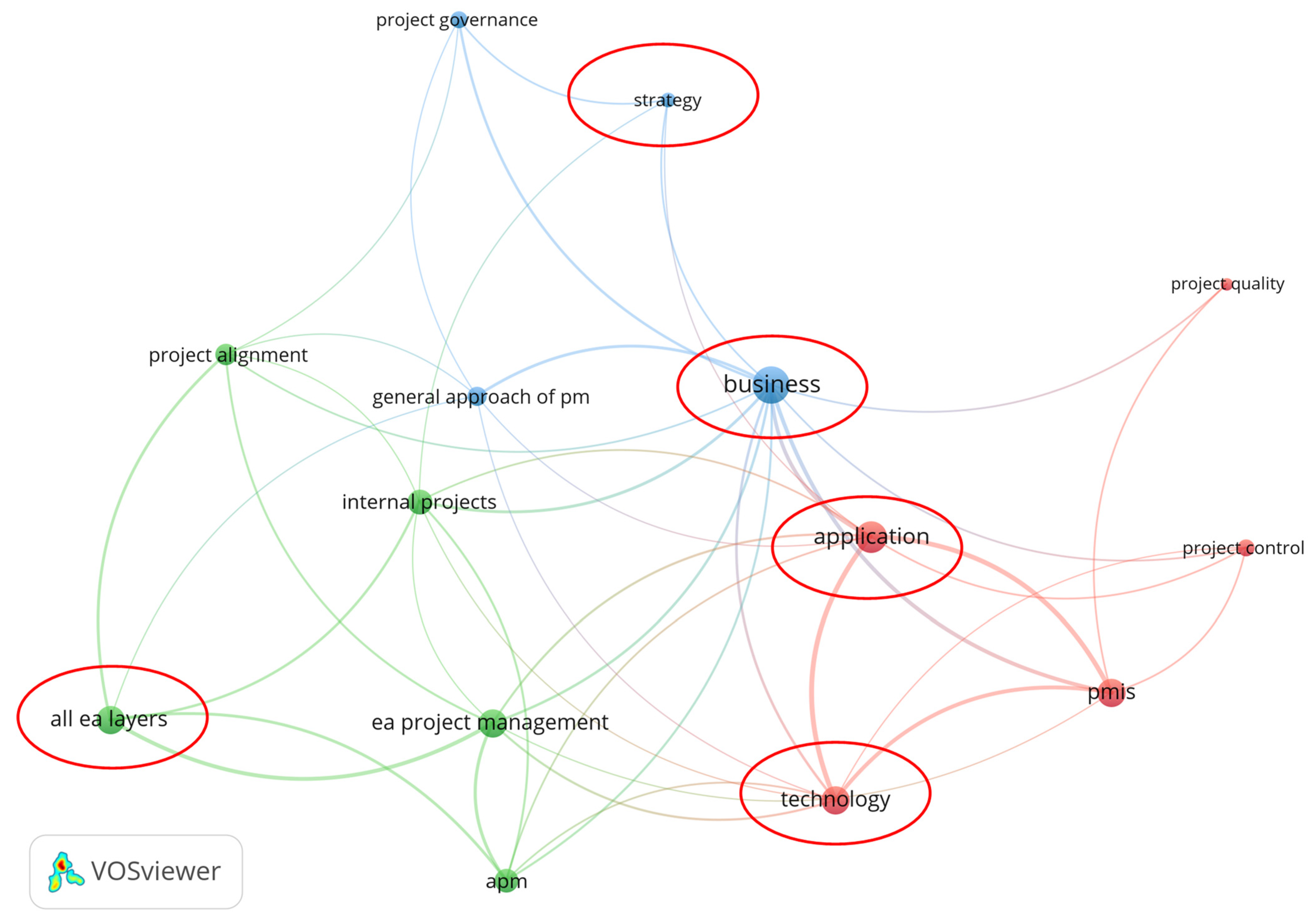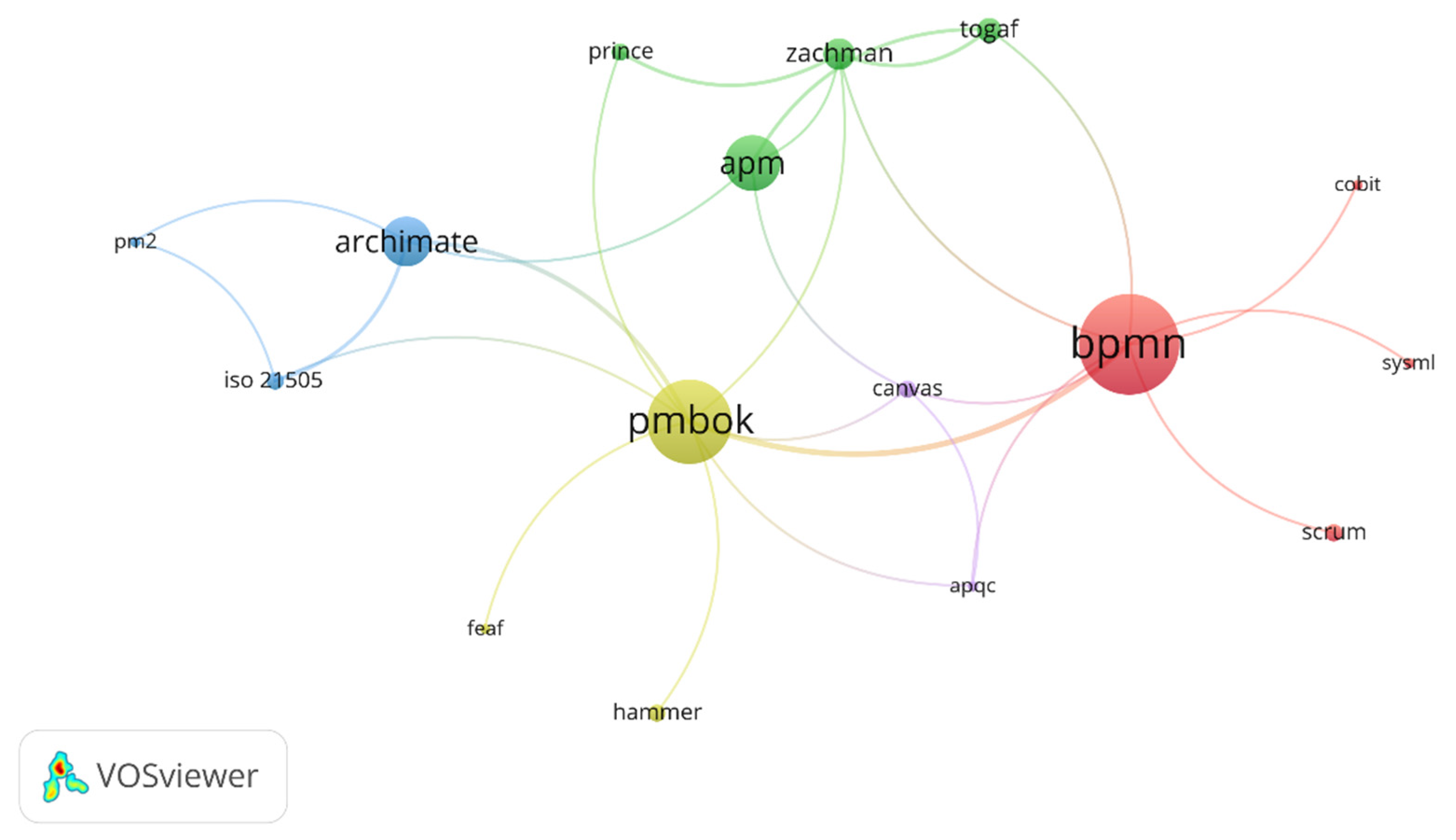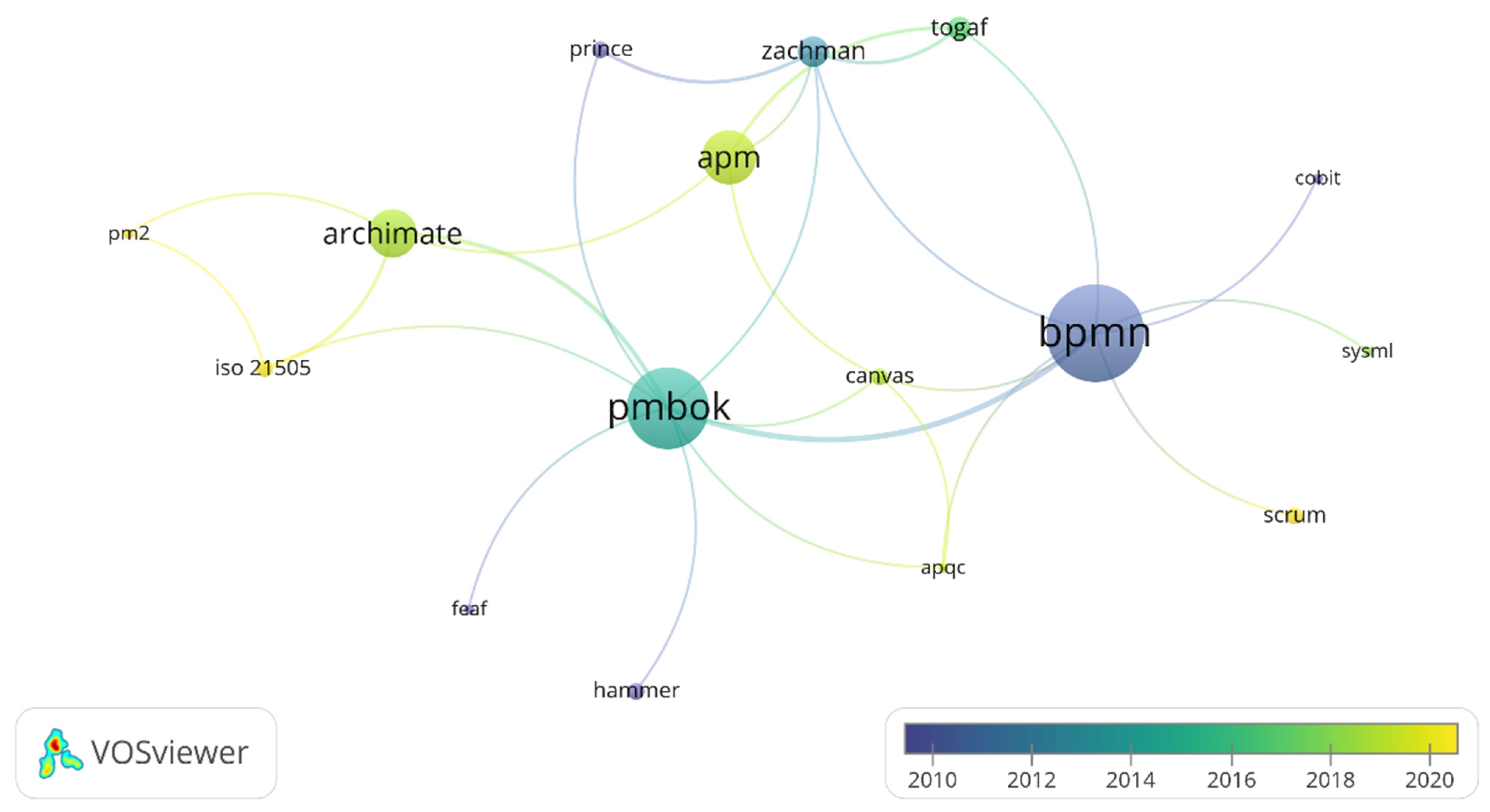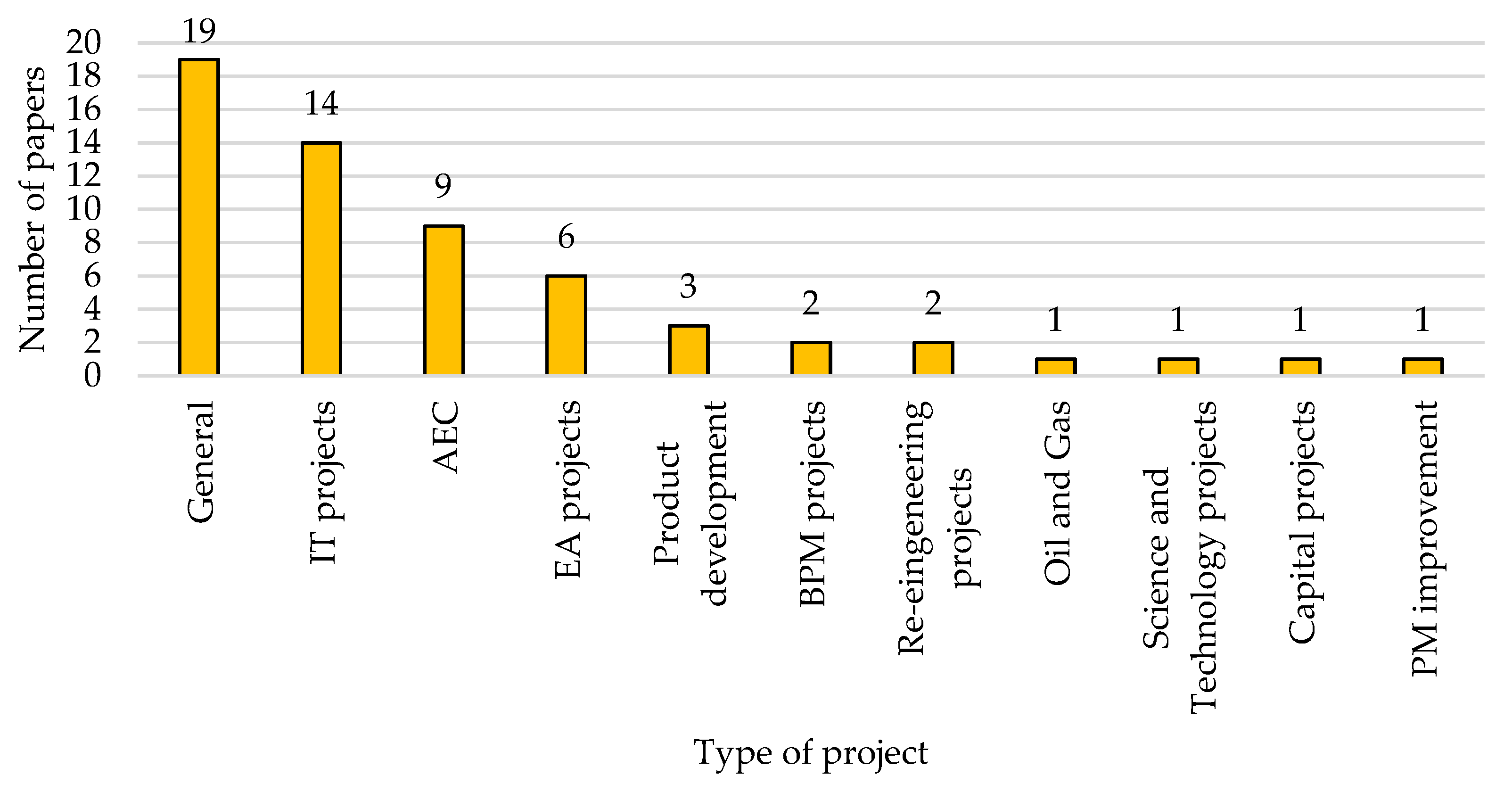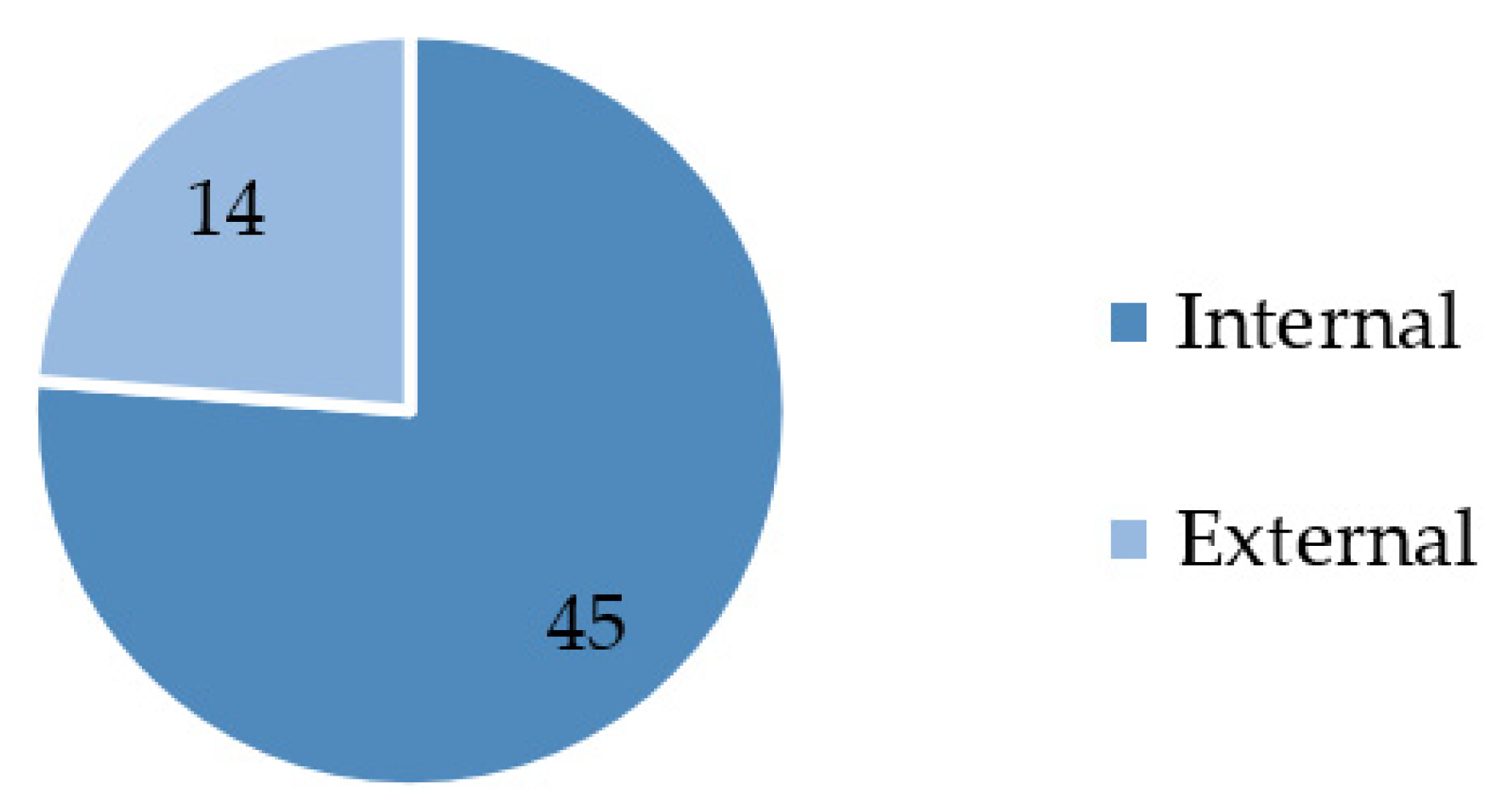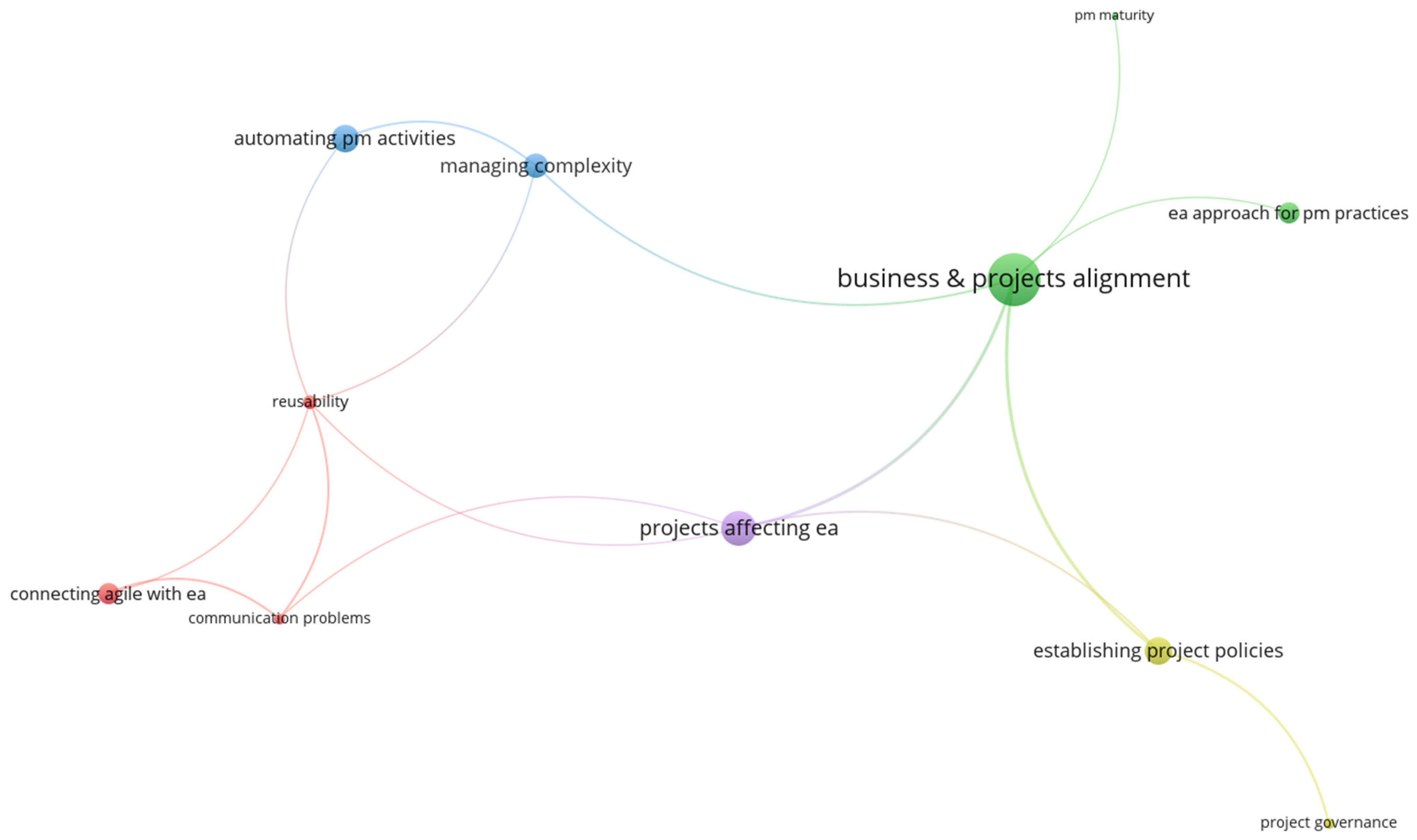1. Introduction
Organizations and projects are important aspects of modern socioeconomic life. Managers devote significant time and effort to improving operations. Their initiatives are often implemented through projects [
1]. In the last thirty years, the PM field has evolved considerably [
2], with increased visibility and relevance [
3]. In conventional organizational theory, projects were conceived as specific activities in a permanent organization (parent company). However, the focus is now on the project concept, its complexity, and the executive team that supports it. In this context, a project is conceived as a temporary organization [
1]. Some organizations partially or completely sustain their value through projects and their respective temporary organizations, project-based organizations (PBOs) [
4,
5,
6]. PM is a core competence in PBOs [
7]. The study of PBOs has focused on specific domains in a PBO context, including resource management, portfolios, programs, and knowledge management. The study of holistic design in PBOs is still in its early stages [
8].
PBO design has been primarily approached from an organizational development perspective [
4]. The Star Model is a widely accepted PBO design guideline that uses this approach [
5]. The model adapts Galbraith’s framework for organizational design [
9] and considers the development and alignment of five components: Strategy, processes, behavior, human resources, and structure. This approach has the advantage of establishing the interdependence of these components and a holistic view of PBO design. Other approaches address these components independently [
8].
For organizational design from a systems-thinking perspective, enterprise architecture (EA) is an alternative for modeling, analyzing, and designing an organization [
10,
11,
12]. EA presents a coherent set of principles, methods, and models to design a company structure using components, considering their business processes, information systems, and IT infrastructure [
13,
14]. Interest in EA has increased in recent years. Organizations continue to discover challenges in the field regarding the development and implementation of EA [
15,
16,
17]. The use of EA as a management tool has several benefits, as an instrument allowing companies to evaluate, adjust, and align policies and systems to achieve business objectives [
18,
19]. EA is also recognized as a tool that facilitates digital transformation, a trend affecting process transformation and sustainable business development [
20,
21]. However, EA is still expanding as a formally adopted management discipline in organizations worldwide [
22]. The value of EA to an organization is not always evident. The perception is that EA is a technical discipline, not a business discipline. Thus, professionals and executives are often reluctant to use EA [
13].
To help position EA as a business management tool, PBO design integrated with PM practices can help construct a perspective including systems thinking and current PBO design and management knowledge. It is helpful to consider that organizations have become more integrated into a systems approach for more successful transformations [
23]. First, it is necessary to review the literature concerning EA in PM and PBOs to understand what has been accomplished. This study considers the following research questions:
RQ1: What are the current state and key dimensions of EA approaches for PM? This question concerns research that formally applies EA to PM. The main contributions of these studies are discussed.
RQ2: What are the current state and key dimensions of EA approaches for PBO design? This question concerns research that formally applies EA to PBO design. The main contributions of these studies are discussed.
RQ3: What are the tendencies of frameworks in EA application in PM and PBOs? This question seeks to identify frameworks used in studies of EA, PM, and PBOs over time.
RQ4: How integrated are the EA, PM, and PBO domains? This question seeks to holistically assess how the EA, PM, and PBO domains are integrated in the literature.
RQ5: What are the main challenges in PM practices with EA presented as an alternative solution? This question seeks to recognize the main challenges in applying EA in the PM domain.
This study aims to determine the state of the art of EA application in PM and PBOs. As such, the findings in the literature are synthesized and summarized using a methodology combining a bibliometric review and a systematic literature review [
24]. Fifty-nine articles were selected for review from PM journals and engineering management.
A review of the articles was conducted using the EA model conceived in [
25], using an analytical framework with four component layers: Strategy, business, application, and technology. Bibliometric and content data were processed through co-occurrence maps and frequency graphs to guide the analysis.
The review indicated no EA applications in PBOs, although some isolated EA components were identified in some papers. In contrast, applications of EA were found in PM. These studies focused on the alignment of local projects with the organization and PM activities in business processes, most focused on IT projects. PM and EA frameworks were identified in the reviewed articles, indicating strong adherence to PMI standards and use of ArchiMate (EA modeling language proposed by The Open Group (OMG) based on IEEE 1471 standard for describing software-system architecture [
25]).
This paper is organized as follows.
Section 2 presents the materials and methods used in this research.
Section 3 presents the results and a discussion. The conclusions, research questions, and future research directions are presented in
Section 4.
4. Discussion
This research has described the current application of EA on PBO and PM domains and gives an overview of the integration between these domains. From a bibliometric perspective, it is possible to identify the increasing productivity of research in the studied field. Northern hemisphere countries concentrate most of the articles, coinciding with the origin of the main EA and PM standards cited in the literature. Most of the selected articles are conference papers. Understanding that these kinds of articles are works in the process of maturing, this situation can be seen as an opportunity for the research field to take current knowledge to the next level. The above could confirm that the systems thinking in PBO and PM are still in their early stages.
Processing the keywords of selected papers—using the data extraction form described in
Table 2—through co-occurrence maps, clusters and interrelationships can be identified, as shown in
Figure 6 and
Figure 7. The three most weighted concepts are EA, PM, and BPM, with PM as a central cluster. It can be seen that early researchers addressed the PM–BPM relationship. Over time, research interest expanded to include EA, culminating in EA–PM components such as governance, layers, portfolio, and programs. This trend is observed in the PM domain. In the first six versions of the PMBOK framework, knowledge was structured in ‘processes’ [
42] and hierarchical composition of PM knowledge [
104]. However, the recent 7th version of PMBOK deploys knowledge through systemically interrelated ‘domains’ [
52,
109].
The content data extracted (using the form of
Table 2) were processed for five types of analyses in
Section 3.5: (1) the relationship through EA layers and PM focuses identified in selected papers. The ‘business‘ layer in an EA is most often addressed in the articles. The above was also reflected in the keyword analysis (
Figure 6), with the management of business processes (BPM) as activities within an EA. The work of Werewka [
95] is highlighted in the blue cluster (
Figure 8), which describes a part of PMBOK 6th edition through an EA model and using the business layer ArchiMate artifacts. As the author mentions, the PMBOK content is best represented through the concepts of business and strategy layers. Moreover, the business layer of an EA is composed of processes. BPM approach is an effective tool for process-oriented organizations allowing for improved performance through sustained application [
110]. PM field has also taken advantage of this and has extended its knowledge from a process perspective, as has already been mentioned with the case of the PMBOK. ‘Application‘ and ‘Technology‘ are also most linked layers with other PM concepts (e.g., PMIS, project control and project quality), mainly covering the need for supporting and automating PM activities. EA brings the language and the structure for modeling the relationship with PM activities from a high level (e.g., task) to a low level (e.g., data architecture). These relationships would reinforce the idea that EA helps organizations to facilitate their digital transformation process, thanks to the integration of its components organizations (from strategy to data), and allow a better understanding of them even as complexity increases [
20,
111,
112]. (2) The EA and PM languages and standards were analyzed through their connections (
Figure 9). PMBOK, as a PM standard and BPMN and ArchiMate as an EA language, are the most used on the selected papers and confirm their wide acceptance again, as shown in
Section 3.4.1. (3) The type of projects mentioned in elected papers were analyzed regarding their frequency. In this case, it was expected that EA applications would mainly focus on IT projects. However, the interest of the AEC industry is surprising because of the attention they have given to EA as a management tool. This relationship can be explained by the current need for digitalization of the AEC sector, characterized by its artisanal processes on site and occupying last place in productivity compared to other sectors [
113]. (4) Selected articles do not directly refer to PBO. This situation would, in principle, show that no EA on PBO has been applied. However, the term PBO might not be fully diffused. Then, alternatively, by analyzing the type of organization mentioned in the articles or where EA is expected to be applied, it is possible to infer the type of PBO alluded to. Therefore, it is observed that EA is mainly being applied (45 out of 59 articles) from an internal PBO perspective, i.e., for projects that are developed within an organization for internal objectives. The rest of the articles focus on offering projects to external clients. This point becomes relevant because some of these articles consider a pre-existing EA to connect projects and their results. It is a coincidence that in the group of external PBOs, we find the AEC industry, which is not characterized by being managed through EA as a business but has been approaching EA as a tool to improve the performance of their projects and facilitate their management. (5) The analysis of EA-PM-PBO integration has a pure systemic objective for understanding the representations of PM knowledge or practices from an EA perspective. The findings confirm the statement of [
68] regarding the lack of integration between these domains and the articles presenting some connections focused on specific PM sub-domains or applying a specific layer of EA. However, there is no complete integration between all layers of an EA and, for example, all PM bodies of knowledge.
The challenges and future research were identified on selected papers and extracted and mapped, as shown in
Figure 14.
Figure 14 contains five clusters. The green cluster (1) is the most heavily weighted. Increasing complexity and study scope in current papers are identified as challenges for future research. Many studies start with simplified models for a proof of concept (POC). Authors have highlighted the need for business analysis automation tools for more complex models [
60,
93,
95,
114,
115,
116,
117]. The red cluster (2) is the second most heavily weighted. Authors in this group have emphasized developing a case study to validate proposals [
68,
100,
114,
118]. A theoretical approach is a constant in these articles. Regarding the POC approach of the proposals, authors mentioned the need to increase the analysis scope, such as extending the EA application to other EA layers [
45,
65] and measuring the proposal performance in actual conditions [
57,
119]. Another concern in this cluster is the trend to rigidise EA applications. A proper mix using the Agile approach may produce a more flexible EA [
51,
53]. The blue cluster (4) indicates author concerns regarding practical application of their proposals. For better proposal applicability in organizations (models, reference architectures), greater standardization of practices and generalization are required to facilitate integration [
34,
94]. These concerns must be considered simply as means for use [
62,
86,
120].
The yellow cluster (5) reflects the challenge for EA and PM integration, which must be systemic to achieve interoperability between project and organization [
23]. There must also be integration and collaboration between project managers and EA to achieve better coupling of solutions with the organization [
121]. Thus, training of project managers and architects is a concern in this cluster.
PM needs to be filled through the application of EA in the selected articles were identified and mapped through co-occurrence, as shown in
Figure 15.
Figure 15 shows that EA application needs consist of five clusters. The green cluster (1) considers business and project alignment, the most heavily weighted EA application. In developing internal projects, requirements and outcomes must be aligned and integrated with the organization for successful achievement of business goals through the project [
121]. EA provides the resources and tools to translate strategy and project objectives into daily operations [
93]. In the green cluster, the use of EA is identified for improving PM practices [
57] and PM maturity [
107], reflecting that EA promotes organizational maturity to complete projects and improve performance [
106].
The second most heavily weighted cluster is purple (2) in
Figure 15. This cluster contains a study about how project development affects an existing EA. This concern was addressed by Foorthuis [
44,
45,
46,
47], who proposed a framework for coupling a local project to the EA, known as the Project Conformance Framework (PCF) [
45] to achieve conformance between the project and the EA, considering all of their components, including artifacts, relationships, and processes.
Application of EA (3) to establish project policies is the third most heavily weighted cluster (yellow) in
Figure 15. This concern is related to the use of EA for project governance, reflecting the organizational need for a decision-making and management framework with transparency, accountability, and well-defined roles [
122]. EA provides tools for establishing policies and governance statements for managing projects and their relationship to the organization.
The blue cluster (4) connects the need to use EA to automate PM activities and manage project complexity. Some projects are developed by combining different organizational components, creating an organizational challenge in managing complex environments [
117,
123]. EA helps to reduce and manage project complexity with detailed understanding and discretization of organizational and project components and their relationships [
60]. Automation of PM activities goes hand-in-hand with complexity management. Using PM automation tools such as PMIS makes PM tasks more sustainable, allows for better decision-making, and increases the chances of project success [
99].
The red cluster (5) indicates the use of EA for the reuse of organizational components and knowledge, managing communication problems, and connecting EA with Agile. This cluster reflects the dynamism that organizations face today, with market changes and constant reconfiguration [
102]. Organizational sustainability requires a representative architecture to sustain business decisions and transformation projects to maintain market competitiveness [
92]. Agile methods have been used for projects with significant adherence in rapidly changing environments [
124]. Thus, this cluster indicates researcher concern in using EA and the Agile approach for organizational transformation. Combining EA and Agile is a challenge. Agile allows flexibility, and EA provides consistency and long-term focus. These benefits sometimes oppose each other [
40].
Finally and regarding the research questions, in response to RQ1, ‘What are the current state and the key dimensions of EA approaches for PM?’, it was found that the key dimensions in applying EA in the PM domain are focused on the business layer. The process perspective facilitates application of PM practices, mainly in early research stages. The use of EA as a tool for project governance is also visualized. In different types of projects in the articles, the need for aligning projects, artifacts, and products with the layers of technology and infrastructure of the organization at the strategic level is highlighted. Most of the referred projects were related to IT.
In response to RQ2, ‘
What are the current state and the key dimensions of EA approaches for PBO design?’, the main finding was that there are no explicit applications of EA. However, it can be inferred that organizations classifiable as PBOs were considered, with the AEC industry appearing in five articles. The application of EA layers has gained research interest in this industry, relieving the need for coordination between different actors in AEC projects. For instance, one case in the AEC industry identified connections between structural engineering and architecture specialties. Such specialties must be properly integrated to achieve the project objectives [
57]. EA was positioned as an alternative solution.
In response to RQ3, ‘What are the tendencies of using frameworks in the application of EA in PM and PBO?’, some trends have been identified in PM and EA frameworks. The main PM framework in the selected articles was PMBOK, confirming its position as the most popular PM standard among researchers and professionals. From an architectural perspective, BPMN is the most-used modeling language (for processes) in the selected articles. ArchiMate is recognized as the most widely used EA language.
Regarding the level of integration between EA, PM, and PBO domains, objects of RQ4, ‘What is the level of integration between the EA, PM, and PBO domains?’, 31 articles considered these domains from a holistic perspective. However, not all were integrated as such. Integration was concentrated between EA and PM domains for individual projects and portfolios. Of these articles, two stand out with a higher generalization level, relating to the FEAF–PMBOK and ArchiMate–PMBOK frameworks.
In response to RQ5, ‘What are the main challenges in PM practices where EA is presented as an alternative solution?’, there were gaps filled by selected papers. The main PM need with the EA approach is alignment between projects and business. EA is considered a governance tool for management. Proper connection of projects and their outcomes with the organization is a concern highlighted in the articles.
5. Conclusions
A literature review was conducted analyzing bibliometric and content information through a systematic review. Of 516 articles found using a keyword group, 59 articles were selected for review. From a meta-based perspective, the works relating EA with PBO or PM domains date from 1996. Since 2005, there has been at least one article per year. An increasing trend was identified and 2021 produced the most articles. The selected works originated mainly from Asia, Europe, and North America, conference papers in most cases. The selected works were categorized in five clusters based on the analysis of co-occurrence of article keywords. EA, PM, and BPM were the most heavily weighted and connected clusters. Over time, this map reflects that in the early stages, PM used a process approach for displaying knowledge (PMBOK 1st–6th editions). It has been demonstrated that a business process approach produces better productivity, quality communication, collaboration, and more efficient information flows in projects. At present, the tools are disseminated in architectural components interconnected in a domain approach (PMBOK 7th edition). PMBOK 7th edition [
52] indicates the importance of systems thinking for PM knowledge, understanding, application, and emerging Agile approaches for flexible PM.
Future research could focus on adding complexity to EA solution proposals for PM. However, the authors reported that automation tools must accompany this objective to facilitate design and analysis. Other challenges identified include the continuing study of EA and PM integration, which must be developed at a conceptual level and between people, such as project managers and enterprise architects. There is an understanding of the benefits of EA for project success, but authors report that sometimes EA adds rigidity. For this issue, Agile is considered an alternative solution, connecting the benefits of EA with the flexibility of Agile.
EA has mostly been applied in IT. The origin of EA is related to IT. The Agile perspective was born from the same field. It seems that the IT sector can anticipate behavior in other sectors, visualizing how industries such as AEC have historically conducted their projects using traditional PM approaches and original IT practices to improve their results.
The world is becoming increasingly digital. Coexistence of people and technology is becoming more intense. Digital transformation is no longer the exclusive concern of the IT sector. Digitalization needs permeate all types of activities, organizations, and projects. Harmonious coexistence with technology as it becomes more complex requires systemic thinking to understand, manage, and improve it. As a management tool with a systemic perspective, EA is considered in different industries and seems to be a means of integrating organizations and developing projects in the digital era.
This study is expected to contribute to researchers and practitioners systemically considering EA and PM domains and demonstrate the value of using EA in project management. From a practical perspective, this article indicates trends such as concerns in using EA and the need for collaboration between project managers and architects. From a research perspective, this article demonstrates that EA is connected to the digital transformation trend and that further development is required to improve the use of EA in more complex environments.
Application in the PBO domain is still a challenge and future research should consider the architecture that characterizes this type of organization.


